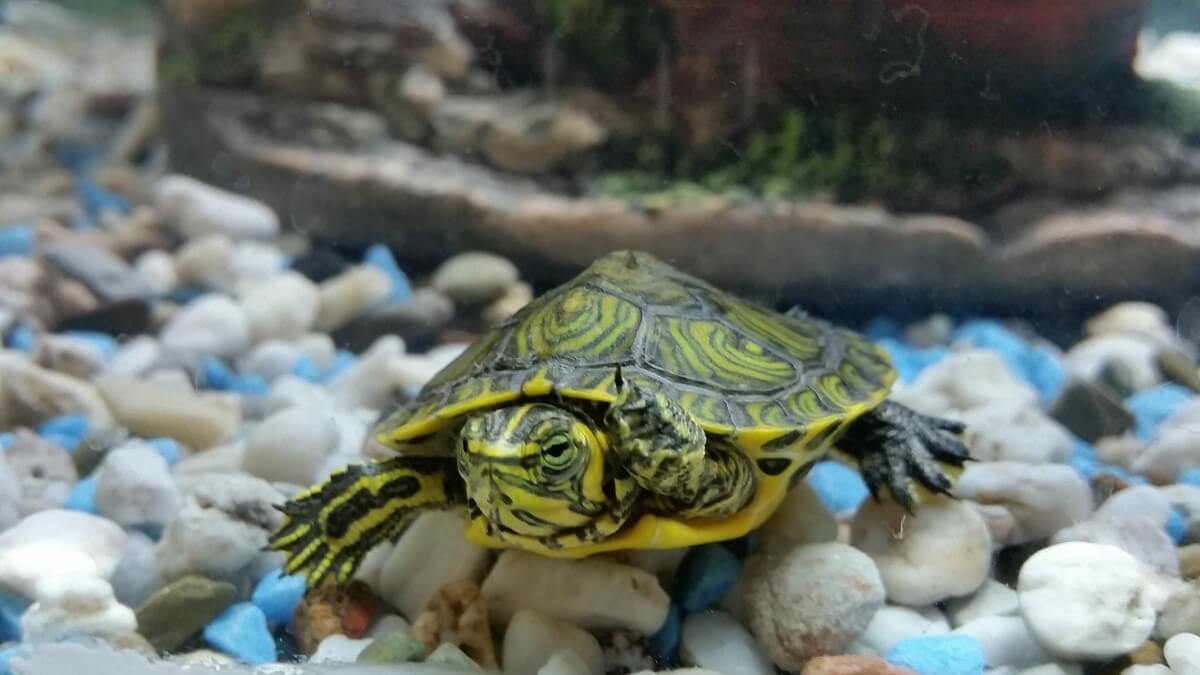Finding the right substrate for your turtle tank is crucial for creating a healthy and stimulating environment for your shelled friend.
For turtle tanks, river rocks or large pebbles are ideal as they prevent accidental ingestion and are easy to clean, ensuring a safe habitat for turtles.
But there’s more to consider than just safety and cleanliness. Stick around to learn how to balance aesthetics, maintenance, and your turtle’s natural behaviors for a thriving habitat.
Types Of Substrate For Turtle Tanks
River Rocks Or Large Pebbles
These are often recommended for turtle tanks due to their size, which prevents turtles from accidentally ingesting them. They’re also easy to clean and offer a natural look to your tank. However, they don’t allow for plant growth if you’re aiming for a planted tank. Here are some river rocks I would recommend.
Sand
Sand can be a good choice for some turtle species, providing a soft substrate that allows for natural digging behaviors. Be cautious, though, as fine sand can lead to impaction if ingested. Keeping clean is also a bit more challenging than larger substrates. I would recommend white sand or black sand.
Bare Bottom
Going without any substrate is a practical choice for those prioritizing ease of cleaning. A bare-bottom tank is straightforward to maintain and reduces the risk of impaction. The downside is the lack of a naturalistic appearance and potentially stressful environment for turtles that prefer digging or burrowing.
Gravel
Gravel might seem like a natural choice for a turtle tank, but it’s a bit of a double-edged sword. On one hand, it can create a visually appealing, naturalistic environment that mimics a turtle’s wild habitat. It’s also relatively easy to clean and comes in various colors and sizes, allowing you to customize your tank’s aesthetic.
However, the main concern with gravel is the risk of impaction. Turtles, especially younger ones, can be curious and may accidentally ingest small pieces of gravel while foraging or exploring.
Factors To Consider When Choosing A Substrate
Safety
The risk of ingestion and impaction is a significant concern. Avoid small, fine substrates that turtles might swallow. Larger, smooth substrates are generally safer and reduce the risk of gastrointestinal blockages.
Ease of Cleaning
Some substrates are easier to clean than others. Consider how much time you’re willing to dedicate to maintenance. Substrates like river rocks are easier to clean than sand or fine gravel, which can trap more debris and require more frequent cleaning.
Water Quality
The substrate can impact the water quality in your tank. Some substrates, like certain types of sand or gravel, can alter the pH of the water or leach chemicals. It’s crucial to choose a substrate that won’t negatively affect the water parameters.
Plant Growth
If you plan to keep live plants in your turtle tank, you’ll need a substrate that supports plant growth. Some turtles may uproot plants, so it’s essential to secure them properly and choose sturdy, turtle-friendly plants.
Common Mistakes To Avoid
- Choosing the Wrong Size Substrate: Small, fine substrates can be ingested, leading to dangerous impactions. Conversely, substrates that are too large might not give your turtle the desired naturalistic environment or behavior opportunities.
- Overlooking the Need for Regular Cleaning: All substrates require maintenance, but some more than others. Neglecting regular cleaning can lead to poor water quality, promoting the growth of harmful bacteria and algae.
- Neglecting Water Quality Impact: Certain substrates can alter the chemistry of your tank’s water, affecting its pH and hardness. Not testing your water regularly after introducing a new substrate can lead to conditions that are harmful to your turtle.
- Using Chemically Treated or Dyed Substrates: These can leach harmful substances into the water, posing a risk to your turtle’s health. Always choose natural, untreated substrates for your tank.
Final Thoughts
Go for larger, smooth substrates to avoid ingestion risks, and keep cleanliness in mind to ensure a healthy environment. Whether it’s river rocks, large pebbles, or a carefully chosen commercial substrate, the right choice will support your turtle’s well-being.
Avoid common pitfalls like choosing the wrong size or neglecting regular cleaning, and you’ll create a thriving habitat where your turtle can happily live.
Related Posts:

